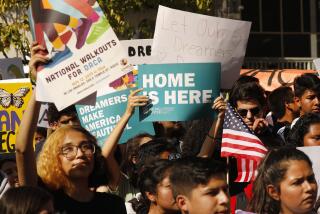Only About 13% Have Filed, Ezell Says : INS Acts to Ease Amnesty Process
LOS ANGELES — Immigration officials, acknowledging that response to the second stage of the amnesty program has gotten off to an alarmingly slow start, unveiled measures Thursday aimed at easing the application process.
“We’re not quite sure if it is confusion or procrastination,” but only about 13% of eligible applicants have bothered to file for permanent resident status so far, Harold Ezell, western regional commissioner of the U.S. Immigration and Naturalization Service, said at a press conference.
“Whatever the reason,” Ezell added, “it is a very serious problem.”
About 1 million immigrants applied for amnesty in the Western states--more than half the nation’s total--and most have gained temporary resident status. But in order to retain their legal status, amnesty recipients must apply for permanent resident status in the program’s second phase that began last fall. (Nearly 800,000 additional immigrants in the West applied for amnesty under a special provision for farm workers, but they are exempt from the second phase’s requirements.)
Few Have Applied
Only about 40,000 of the more than 300,000 amnesty applicants in the region who are eligible have filed so far for permanent resident status. The others will become eligible as their staggered deadlines come due over the next 9 months.
The deadlines are part of the confusion, INS officials and immigrant advocates agree. Starting on the date that an immigrant filed for temporary resident status, the applicant must remain in that category for 18 months before becoming eligible for permanent resident status. Applicants then have 1 year to apply for permanent residency. If they fail to do so, they revert to illegal status.
To encourage the timely filing of applications, INS officials announced a fundamental change in the process. Applicants may now file permanent resident applications immediately. Application forms are available at all INS legalization offices.
“If you’re confused as to when to file . . . or in doubt, file now,” said Ernest Gustafson, Los Angeles INS district director.
Gustafson said the INS will then notify these applicants as their eligibility deadline approaches and their permanent resident interviews come up.
Other steps aimed at clearing the confusion over the law’s requirements include establishing full-time information booths at all INS legalization offices and increasing publicity, Ezell said.
Church Group Exams
Officials also announced that the “proficiency exam”--which applicants may now take at INS legalization offices in lieu of a required English, U.S. history and government course--will soon be offered by community and church organizations as well.
The first of many groups expected to offer the test, beginning in about two weeks, are: Catholic Charities of the Los Angeles Catholic Archdiocese; St. Simon’s Episcopal Church in San Fernando; The Private Immigration Agency based in Huntington Park, and the Bellflower chapter of the League of United Latin American Citizens.
Although immigrant advocates generally lauded the INS’ latest efforts at encouraging a greater response from amnesty applicants, they urged the agency to go even further in its efforts.
“We’re going to have to use many different creative ways,” said Stewart Kwoh, director of the Asian Pacific American Legal Center of Southern California. “There is a great need for a stronger and more concerted outreach effort.”
More to Read
Sign up for Essential California
The most important California stories and recommendations in your inbox every morning.
You may occasionally receive promotional content from the Los Angeles Times.









